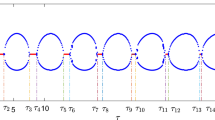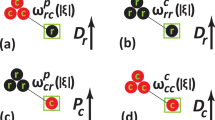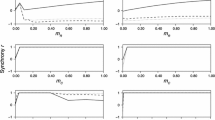Abstract
The stability conditions for an isolated specialist predator-prey community are fairly well understood. The spatial coupling of several such systems through dispersal of individuals can generate new dynamic behavior that is not yet completely understood. Many factors are known to be stabilizing or neutral, e.g., random dispersal or time delays, while others may induce instabilities in some cases but not others, e.g., density-dependent movement. We study the combination of two stabilizing mechanisms in a two-patch Rosenzweig-MacArthur model with a novel density-dependent movement term. Specifically, we assume that prey move between patches according to their perceived predation risk, and we include travel time between patches as a time delay. We show that the combination of mechanisms may be destabilizing even though each mechanism by itself is stabilizing. Our results show that a detailed knowledge of mechanisms and their temporal scales is necessary to correctly predict the stability of a metacommunity.





Similar content being viewed by others
References
Abdllaoui AE, Auger P, Kooi BW, De la Parra RB, Mchich R (2007) Effects of density-dependent migrations on stability of a two-patch predator–prey model. Math Biosci 210(1):335–354
Abrams P, Ruokolainen L (2011) How does adaptive consumer movement affect population dynamics in consumer resource metacommunities with homogeneous patches? J Theor Biol 277:99–110
Abrams PA (2007) Habitat choice in predator-prey systems: spatial instability due to interacting adaptive movements. Am Nat 169(5):581–594
Auger P, de La Parra RB, Poggiale J-C, Sánchez E, Sanz L (2008) Aggregation methods, in dynamical systems and applications in population and community dynamics. Physics of Life Reviews 5(2):79–105
Bélisle M (2005) Measuring landscape connectivity: the challenge of behavioral landscape ecology. Ecology 86(8):1988– 1995
Briggs CJ, Hoopes MF (2004) Stabilizing effects in spatial parasitoid–host and predator–prey models: a review. Theor Popul Biol 65(3):299–315
Cantrell R, Cosner C (1996) Models for predator-prey systems at multiple scales. SIAM Rev 38(2):256–286
Chakraborty A, Singh M, Lucy D, Ridland P (2007) Predator-prey model with prey taxis and diffusion. Math Comput Model 46:482–498
Cobbold C, Lutscher F (2014) Mean occupancy time: linking mechanistic movement models, population dynamics and landscape ecology to population persistence. J Math Biol 68:549–579
Cooke KL, Grossman Z (1982) Discrete delay, distributed delay and stability switches. J Math Anal Appl 86(2):592–627
Cuddington K, Yodzis P (2002) Predator-prey dynamics and movement in fractal environments. Am Nat 160:119–134
Goodwin BJ, Fahrig L (2002) Effect of landscape structure on the movement behaviour of a specialized goldenrod beetle, Trirhabda borealis. Can J Zool 80(1):24–35
Hanski I (2001) Spatially realistic theory of metapopulation ecology. Naturwissenschaften 88(9):372–381
Hanski I, Gilpin M (1991) Metapopulation dynamics: brief history and conceptual domain. Biol J Linn Soc 42(1-2):3–16
Hauzy C, Hulot FD, Gins A, Loreau M (2007) Intra-and interspecific density-dependent dispersal in an aquatic prey–predator system. J Anim Ecol 76(3):552–558
Hauzy C, Gauduchon M, Hulot FD, Loreau M (2010) Density-dependent dispersal and relative dispersal affect the stability of predator–prey metacommunities. J Theor Biol 266(3):458–469
Jansen VA (1995) Regulation of predator-prey systems through spatial interactions: a possible solution to the paradox of enrichment. Oikos:384–390
Jansen VA (2001) The dynamics of two diffusively coupled predator–prey populations. Theor Popul Biol 59 (2):119–131
Kinlan BP, Gaines SD (2003) Propagule dispersal in marine and terrestrial environments: a community perspective. Ecology 84(8):2007–2020
Kinlan B P, Gaines S D, Lester SE (2005) Propagule dispersal and the scales of marine community process. Divers Distrib 11(2):139–148
Klepac P, Neubert MG, van den Driessche P (2007) Dispersal delays, predator–prey stability, and the paradox of enrichment. Theor Popul Biol 71(4):436–444
Kot M (2001) Elements of mathematical ecology. Cambridge University Press, Cambridge
May RM (1973) Stability and complexity in model ecosystems. Princeton University Press, Princeton
McCauley E, Wilson W, de Roos A (1993) Dynamics of age-structures predator-prey interactions: individual based models and population level formulations. Am Nat 142:412– 442
Mchich R, Bergam A, Raïssi N (2005) Effects of density dependent migrations on the dynamics of a predator prey model. Acta Biotheor 53(4):331–340
Mchich R, Auger P, Poggiale J-C (2007) Effect of predator density dependent dispersal of prey on stability of a predator–prey system. Math Biosci 206(2):343–356
Nathan R, Giuggioli L (2013) A milestone for movement ecology research. Movement Ecology 1:1
Neubert M G, Klepac P, Van den Driessche P (2002) Stabilizing dispersal delays in predator–prey metapopulation models. Theor Popul Biol 61(3):339–347
Nieminen M (1996) Migration of moth species in a network of small islands. Oecologia 108(4):643–651
Nystrand M, Griesser M, Eggers S, Ekman J (2010) Habitat-specific demography and source–sink dynamics in a population of Siberian jays. J Anim Ecol 79(1):266–274
Ramanantoanina A, Hui C, Ouhinou A (2011) Effects of density-dependent dispersal behaviours on the speed and spatial patterns of range expansion in predator–prey metapopulations. Ecol Model 222(19):3524–3530
Ricketts TH (2001) The matrix matters: effective isolation in fragmented landscapes. Am Nat 158(1):87–99
Rosenzweig ML, MacArthur RH (1963) Graphical representation and stability conditions of predator-prey interactions. Am Nat 97(895):209
Ruokolainen L, Abrams P, McCann K, Shuter B (2011) The roles of spatial heterogeneity and adaptive movement in stabilizing (or destabilizing) simple metacommunities. J Theor Biol 291:76–87
Sapoukhina N, Tyutyunov Y, Arditi R (2003) The role of prey taxis in biological control: a spatial theoretical model. Am Nat 162:61– 76
Strevens CM, Bonsall MB (2011) Density-dependent population dynamics and dispersal in heterogeneous metapopulations. J Anim Ecol 80(1):282–293
Taylor AD et al (1990) Metapopulations, dispersal, and predator-prey dynamics: an overview. Ecology 71 (2):429–433
Wall E, Guichard F, Humphries AR (2013) Synchronization in ecological systems by weak dispersal coupling with time delay. Theoretical Ecology 6(4):405–418
Acknowledgments
YZ is partly supported by the Centre de Recherches Mathématiques (Montréal) through the pan-Canadian thematic year “Model and methods in ecology, epidemiology and public health (2013)”. FL gratefully acknowledges funding from the Natural Science and Engineering Research Council of Canada (NSERC). FG acknowledges support from NSERC through the Canadian Healthy Oceans network (CHONe).
Author information
Authors and Affiliations
Corresponding author
Appendices
Appendix A: Stability of the coexistence steady state when τ=0
In this appendix, we demonstrate that the coexistence steady state for the two-patch model (2.2) with τ=0 is stable if and only if the coexistence state is stable for the single-patch model (2.3). The transformation introduced in Hauzy et al. (2010) gives a block-diagonal matrix whose stability properties can easily be determined.
We denote the vector of densities on patch i with X i =(h i ,p i )T. Then system (2.2) with τ=0 can be written as
where
The crucial transformation consists of the change of variables: U=(X 1+X 2)/2,V=(X 1−X 2)/2. Then, system (4.1) is equivalent to
Linearizing system (4.2) at the coexistence state U ∗=(h ∗,p ∗)T,V ∗=(0,0)T, we get the linear system
where D F(⋅) and D G(⋅) denote the Jacobian matrix of functions F and G, respectively. This system is in block-diagonal form, and the steady state is stable if all eigenvalues of the two matrices D F(U ∗) and D F(U ∗)−2D G(U ∗) have negative real parts.
We calculate both matrices.
and D F(U ∗)−2D G(U ∗)=
Since the determinants of both matrices are positive, stability depends on the sign of the two traces. Since the trace of the second matrix is smaller than the one of the first, the coexistence state is stable precisely when the trace of D F(U ∗) is negative. But the matrix D F(U ∗) is precisely the community matrix of the single-patch Rosenzweig-MacArthur model (2.3).
The same method gives the additional result that (k,0,k,0) is stable for Eq. 2.2 if and only if (k,0) is stable for the single-patch system. That is, the local stability of symmetric equilibria does not depend on the values of d and α.
Appendix B: Zeros of a transcendental polynomial
A key element in our analysis is the control of eigenvalues with a positive real part of the linearization at the coexistence state. The following lemma from (Cooke and Grossman 1982) shows that in our case, an eigenvalue with a positive real part can only appear by passing through the imaginary axis and not, for example, in a saddle-node bifurcation. For ease of referral and convenience of the reader, we state this not-so-well-known lemma here.
Lemma 4.1 (Cooke and Grossman (1982))
Let f(λ,τ)=λ 2 +a 1 λ+a 2 λe −τλ +a 3 +a 4 e −λτ , where a i and τ are real numbers and τ≥0. Then, as τ varies, the sum of the multiplicities of zeros of f in the open right half-plane can change only if a zero appears on or crosses the imaginary axis.
Rights and permissions
About this article
Cite this article
Zhang, Y., Lutscher, F. & Guichard, F. The effect of predator avoidance and travel time delay on the stability of predator-prey metacommunities. Theor Ecol 8, 273–283 (2015). https://doi.org/10.1007/s12080-015-0269-5
Received:
Accepted:
Published:
Issue Date:
DOI: https://doi.org/10.1007/s12080-015-0269-5




